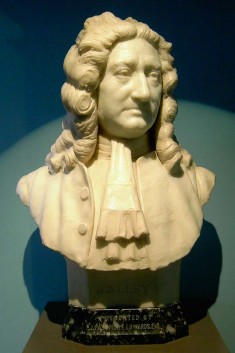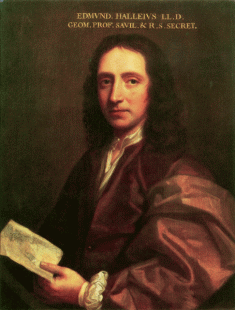Edmund Halley was an English astronomer whose first name is sometimes spelled “Edmond.” He is best known for determining the orbit of the periodic comet that came to be named after him. He also theorized correctly that the phenomenon of the aurora borealis had a magnetic cause. He followed John Flamsteed in the position of Britain’s Astronomer Royal. Halley was something of a polymath, having interests in physics, mathematics, meteorology and geophysics as well as astronomy.
Early Life and Education
Halley was born in the London district of Haggerston on October 29, 1656, the son of a well-to-do soap-boiler. The boy was sent to St. Paul’s School, where he soon displayed promise in both mathematics and classical subjects. While still at school, he had observed the way that a compass changed in its readings as time went on, a function of the movement of the Earth’s magnetic poles. When he was 19, he came up with a new way to determine planetary orbits, after realizing that the tables then in use contained significant errors.
Halley then went to Oxford Universty’s Queen’s College. He wanted to complement Helvelius and Flamsteed’s northern hemisphere star catalogs by performing equivalent observations for the southern hemisphere. King Charles II agreed to recommend him to the East India Company for a voyage to the English colony of St. Helena in 1676.
During the journey, Halley noticed a pendulum’s apparent slowing down as the Equator neared. While on the island itself, he was able to observe a transit of Mercury in November of 1677. From this, he realized that such events would be helpful in more accurately fixing the distance of the Sun.
European Travels
Halley registered more than 340 southern hemisphere stars, a work of great dedication and importance which led his name to be mentioned in the same breath as an earlier great observer, Tycho Brahe. Upon his return to England in 1678, he earned a degree of Master of Arts, and late that year he was elected as a fellow of the prestigious Royal Society. In the spring of 1679, Halley set out on another journey, this time to Danzig on the North Sea coast. Here, he helped to settle a festering argument between two other scientists, Helvelius and Hooke, about whether telescopic or plain sights were to be preferred.
In 1680, Halley traveled across Europe, during which he observed that year’s great comet in Paris along with Giovanni Domenico Cassini. He returned home in 1682, at which point he married Mary. Their 55-year marriage was calm and happy.
From his new home in Islington, Halley spent most of his time observing the Moon, something he felt was key to the then-unsolved problem of fixing longitude with accuracy at sea. Meanwhile, he realized that the solar system’s central force decreased as the inverse square of the distance. Hooke and Wren were of little help, so he went to Cambridge to consult the great Isaac Newton.
Later Life and Legacy
 In 1696 saw Halley become the deputy comptroller of the Chester Mint, and two years later he was commissioned as captain of a ship named the Paramore Pink. This allowed him to set out on a two-year voyage to the South Atlantic in order to make observations regarding magnetism. Closer to home, he published an excellent map of the English Channel’s coastal and tidal conditions in 1702.
In 1696 saw Halley become the deputy comptroller of the Chester Mint, and two years later he was commissioned as captain of a ship named the Paramore Pink. This allowed him to set out on a two-year voyage to the South Atlantic in order to make observations regarding magnetism. Closer to home, he published an excellent map of the English Channel’s coastal and tidal conditions in 1702.
After a short journey to the Dalmatian coast, Halley became a geometry professor at Oxford, and in 1705 he set out his belief that the comet of 1682 would return in 1758. He received an honorary doctorate of law in 1710. A few years later, he was appointed the Royal Society’s secretary, a post he held for eight years.
Many of Halley’s works endured, such as his discovery of the mean motion of the Moon. His work on transits of Venus was also of great importance to astronomers as late as the 19th century. He was a fairly prolific author, producing around 80 scientific papers, although not all of these have proved to be of lasting value.
By 1720, however, he had largely ceased to publish, and in this year he was appointed to the post of Astronomer Royal. Despite his relatively advanced age, Halley was able to plan and complete an 18-year study of a full revolution of the Moon’s nodes. He did not, however, live to see the return in 1758 of the comet whose orbit he had plotted; he died at the age of 85 in January of 1742, and was buried in Lee, Kent.
